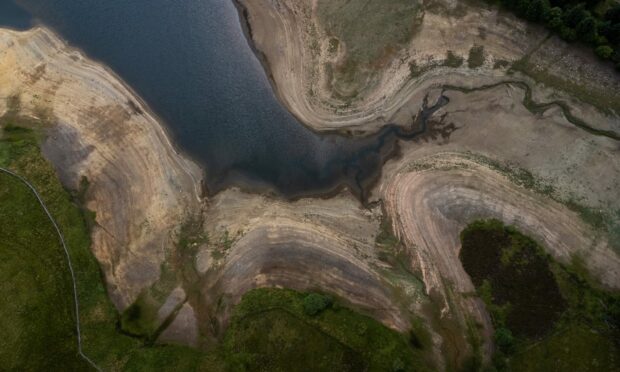Despite this summer’s dry weather, it still may be “hard to wrap your head around” the concept of water shortages in Scotland.
But environment-agency Sepa has now suspended the majority of water removal licences in the River Eden catchment in Fife to protect wildlife in rivers, burns and ponds.
And Scottish Water officials – who manage the public supply – have said reservoir levels are below average for the time of year.
They are at 69% in the east of Scotland as opposed to 80% nationally.
Scottish Water staff are topping up some reservoirs from alternative water sources to ensure “supply resilience” for customers.
For example, they are shifting water from Glenfarg Reservoir to Glen Devon, where once submerged building have recently become exposed again due to falling water levels.
They are urging customers to be careful with water.
Scottish water has, however, no plans to introduce a hosepipe ban. The last time that happened in Scotland was 1995.
Instead, they are advising customers to conserve water.
That could mean taking shorter showers, using a watering can in the garden and turning the tap off when you brush your teeth.
Lower rainfall hits wildlife
But lower than average rainfall still means bad news for wildlife in the east of Scotland.
Sepa says the main part of the Eden is at the second lowest level on record – only 1989 was lower.
The agency says river and groundwater levels have become critical in the east of Scotland.
The extraction ban will pose a problem for farmers who rely on the water to irrigate many key crops.
Sepa are imposing the suspension from midnight on Saturday, August 13.
The Eden is one of the two main rivers in Fife.
It is nearly 30 miles (48 km) long. It flows from Burnside, near the border with Perth & Kinross, across the Howe of Fife next to Strathmiglo and through Cupar.
Then onto Guardbridge, entering the North Sea via the Eden Estuary,
It is home to trout, salmon and many bird species, among others.
What have Sepa officials said?
David Harley is a interim chief officer at SEPA.
He said: “Having to impose suspensions on water abstractions underlines the severity of the conditions being experienced in the east of Scotland this summer.
“It is not a step we take lightly, but the evidence is clear, and it is one we can no longer avoid.
“We’re working closely with Scottish farmers to ensure the sustainability of local water environments for all who rely on them.
“Without action, there is a substantial risk of impacts on fish populations, natural habitats and longer-term damage to watercourses.”
Should I be worried about my local water supply?
The impact on the public water is not currently so severe.
Dr Sarah Halliday is a lecturer in geography and environmental sciences.
She said public water users – which is about 97% of us – will be able to rely on “resilience” in the Scottish Water network.
However, Sarah feels it’s important people become more conscious of their water use.
She said: “What we probably need to be doing in Scotland is moving to a place where people are much more aware of their water use.”
She suggests measures such as water butts in gardens to collect rain water, as opposed to watering gardens with a hosepipe.
“Because water is included in council tax bills, people feel like it’s free so might overuse it.
“We need people to think carefully about how they are using it.”
But she stresses we’re not yet in a “doomsday” scenario.
Although a few people – mostly in rural areas on a private water supply – could have to deal with shortages.
Meaning the majority should be fine for now.
Will climate change affect Fife and Tayside water levels in the long term?
Sarah said changes in rain patterns thanks to climate change might affect reservoir water levels in future.
“The idea of water scarcity is something people don’t attribute to Scotland.
“It can be quite difficult to wrap your head around, especially when we are also facing flooding risks.
“The type of balance we have in our rainfall is changing. We are switching to these very intense, short spells of rain.”
And that isn’t good for water management.
Sarah used the example of rain on a garden lawn.
If the rain is frequent and steady, then it will soak naturally into grass. But if it’s heavy rain, then it will sit on top of the soil.
Sarah said: “That type of rainfall is no good for recharging.”












Conversation